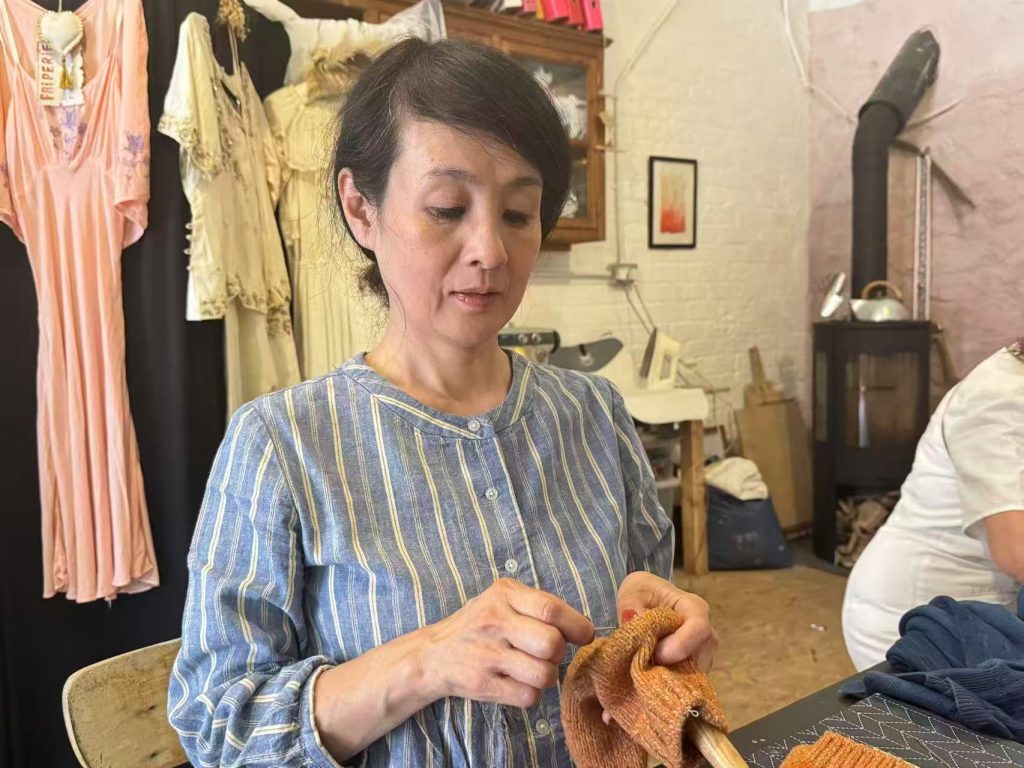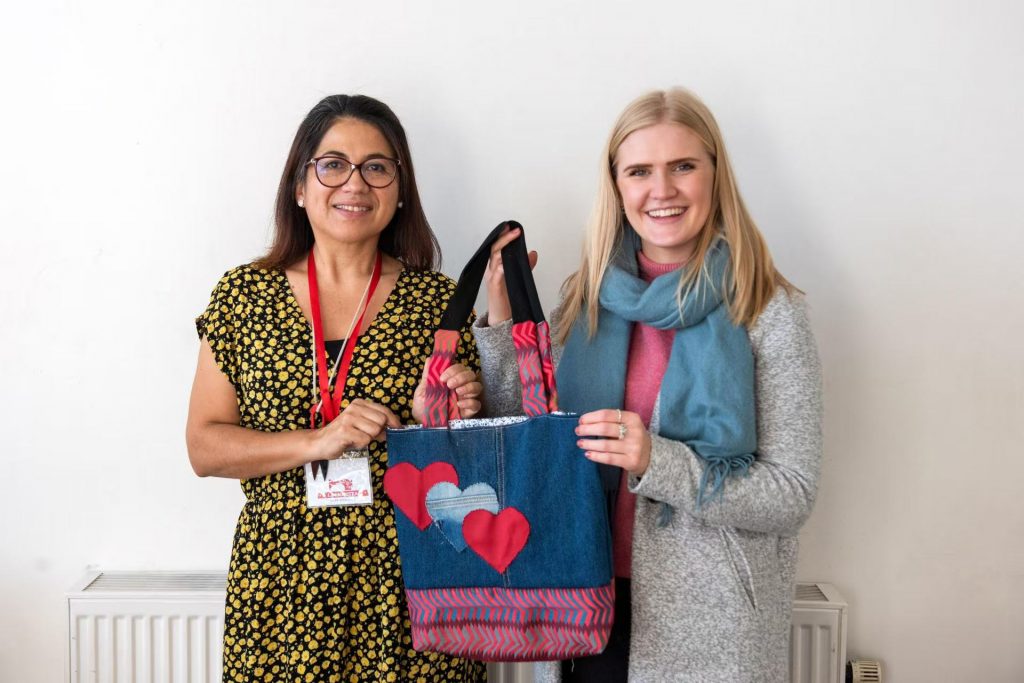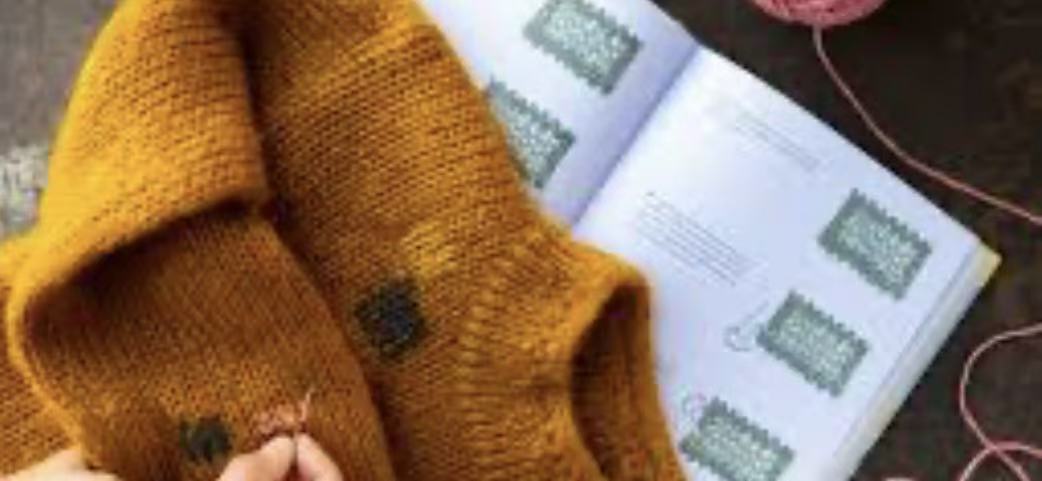Fast fashion harms the environment, but repairing clothes is rising. How does it boost creativity and well-being?
Makiko Kita puts on her glasses and threads the needle with her tongue sticking out the side of her mouth. She slides a doorknob-shaped darning mushroom into the sock she has worn for years and begins to weave the thread between the wool to pull the hole together.
Her friends advised her to throw the socks away, but to multimedia artist Kika, the act of mending is one of quiet contemplation.
“Mending clothes is not just a practical act—it carries deeper meaning about restoring one’s thoughts, spirit, and soul. In Japan, for example, there used to be very few secondhand shops. People preferred buying high-quality, durable items and were reluctant to throw them away. Now, however, the idea of mending and sharing the stories behind clothes is becoming popular as a way to cherish and pass on memories,” she says.

The report Fixing Fashion: Clothing Consumption and Sustainability, released by the UK Parliament’s Environmental Audit Committee (EAC) in 2019, pointed out that “the current development of the fashion industry is unsustainable for both the Earth’s resources and human society.”
In the UK, the purchase of clothing alone generates up to 26.5 million tons of carbon emissions annually—almost half of the country’s annual emissions from private cars. Moreover, producing a single pair of jeans requires an average of 7,500 liters of water, equivalent to one person’s drinking water consumption for seven years.
Additionally, approximately 300,000 tons of clothing are discarded in the UK each year, ultimately being buried or burned, exacerbating the problem of waste. Therefore, the report calls for the establishment of a “circular fashion system” to alleviate environmental pressure by extending the lifespan of clothing, promoting repair, and encouraging the circulation of secondhand garments.
As awareness of the environmental impact of fast fashion continues to grow, organizations and communities such as Repair Café UK and the Making n Mending Club have emerged, dedicated to promoting the repair of old clothes and extending the lifespan of garments. These groups not only encourage people to reduce their purchases of new clothing but also help individuals find healing and comfort through the act of mending.
Research from the Mend.IT project shows that individuals materialize memories and family stories by sewing old clothes, endowing garments with unique emotional value. From this, it becomes evident that mending has moved beyond practical utility and become a meaningful practice for carrying emotions and memories—a quiet yet powerful method of emotional healing.
Cat Lewis, the head of the Making n Mending Club, expresses her remembrance of a late friend through sewing and making. “My friend passed away last year, and I inherited all her clothes. I sold many of them, but I kept a few pieces. I used her pajamas to make colorful bunting. There was a beautiful dress of hers I really liked, but it was too small for me to wear, so I turned it into a small cushion. I also used her embroidered dress to make a bigger one,” she said.

British visual and sensory anthropologist Sarah Pink noted that old clothes carry “emotional imprints,” such as usage marks, odors, and stitching patterns, which can evoke emotional connections with specific people and events. Sewing old garments has thus become a conscious act of memory-making, helping individuals piece together fragmented recollections.
At the front desk of a Repair Café in Cardiff, Margaret, who is responsible for reception, is a witness to this kind of “emotional repair.” She pointed to the floral vest she was wearing and smiled, saying, “This used to be a dress I loved when I was young. The quality and style were great, and I didn’t want to throw it away. I can’t fit into it now, so I cut off the bottom and turned it into a vest.” For Margaret, this was not only a skillful transformation but also a way to carry forward memories from her past life.
According to a report released by the UK’s Crafts Council, 88% of participants believe that engaging in crafts can effectively reduce anxiety, and 73% say it helps improve symptoms of depression.
Participating in craft activities such as sewing and mending has been shown to reduce stress and anxiety while promoting mental well-being. The focus required during hand sewing shifts attention away from emotional distress and helps soothe the mind.
“I had breast cancer and went through treatment seven years ago. I didn’t want to do anything. My eyes were tearing up, and I felt very tired. Then I started hand sewing because it was something I could do lying in bed or take to the hospital. I used linen from home to make myself a linen nightdress because I felt hot and uncomfortable but still wanted to wear something pretty,” Cat calmly shared.
In her view, mending was not just about fixing clothes, but about healing her life. “I really felt like I wasn’t just fixing clothes—I was fixing and organizing my life. It helped me get through that hard time. I found sewing very peaceful, relaxing, and healing. So I started with hand sewing, trying to get better while preparing clothes and taking care of myself,” she said.
Similar cases of using sewing to cope with illness are not uncommon. The community blog Crafting, Mindfulness, and Coping with Cancer: Helen’s Story by Macmillan Cancer Support tells Helen’s experience. Diagnosed with secondary breast cancer in March 2021, she endured a range of intense emotions, such as fear, anxiety, and panic.

“When I start thinking about my own death, the emotions I feel are very uncomfortable. My heart rate accelerates, and I even start to panic. I need to find a way to cope,” Helen said.
She began sewing and knitting to redirect her focus and calm her thoughts. “When I’m knitting or sewing, I can focus on the rhythm, and it helps calm my mind. It takes me away from thinking about the cancer.”
Helen also created small handmade clothes for her grandchildren as a legacy. These works not only embodied familial love but also gave her emotional comfort and strength. “When I feel so uncertain, these crafts make me feel a sense of control. It’s a way to express myself and find meaning in life, even though I’m sick,” she added.
Numerous studies confirm that needlecraft has significant positive effects on mental health and well-being. It fosters social connections, enhances satisfaction, and strengthens both familial and cultural identity . Sewing can heal the soul, give people strength in times of difficulty, and help them regain a sense of purpose. It also helps individuals overcome loneliness, reintegrate into society, and re-establish meaningful connections with others.
According to a survey released by London Recycles, during the pandemic, prolonged home isolation led many Britons to pick up sewing as a way to pass time and combat loneliness. Approximately one-quarter of Londoners reported repairing their clothes more frequently during lockdowns, especially among younger generations.
As restrictions lifted, sewing evolved from a personal coping mechanism into a form of communal interaction. In cities like London, community spaces such as Mending Circle now serve as hubs for residents to gather, share stories, and support one another. At Kennington’s Mending Circle, participants mend clothes together twice a month during informal tea sessions, exchanging both practical skills and warm companionship.

The “Meet, Make, Mend” project, a collaboration between Bristol Textile Quarter and Changes Bristol, provided introductory sewing kits and slow-sewing workshops. About 80% of participants reported a heightened sense of belonging and community connection, and many continued attending sessions post-pandemic to reduce loneliness and rebuild social ties. Charitable organizations like Sew Positive also run community sewing courses to help socially isolated individuals—including the long-term unemployed and those with mental health challenges—regain confidence and find platforms for connection and support.
The Making n Mending Club, founded by Cat, also offers a warm, inclusive space for sewing enthusiasts. People come not only to mend garments but to connect, chat, and learn from one another. “It’s truly become a social gathering. Everyone is sewing and talking at the same time. We usually bring food and drinks, share items, and tell the stories behind them. It’s full of warmth and interaction,” said Cat.
Research on community art and sewing initiatives—such as the Intergenerational Aesthetic Co-Creation project—shows that older adults who sew alongside volunteers and peers enhance their confidence and creativity, expand their social networks, and receive valuable emotional support and a sense of belonging.
“For elderly people who may feel lonely at home for long periods, having a gathering place is very meaningful. They can meet others, repair clothes together, and communicate. It helps ease loneliness and strengthen social connections,” Cat added.
Through shared sewing experiences, people not only repair clothes but build emotional bridges. A summary by Wordplay noted that such activities attract people of different generations and backgrounds. As skills are exchanged, so too are life stories, deepening community bonds and spiritual connection.
“Weaving and mending activities are a great cross-generational integration. Many participants are around 50 or 60 years old, but there are also many young students and men. While the numbers may seem small at first glance, we also have male, transgender, and LGBTQ members here, forming a diverse and broad community. Through this mixture, I’ve learned a lot about different lifestyles and gender identities. Being with young people is very valuable to me. I think they appreciate elders who are skilled and willing to share. So this is truly a space of cross-generational exchange and learning,” Cat said.
Collier, von K á rolyi and other scholars proposed the concept of “textile restoration”, pointing out that fiber handicrafts such as knitting and embroidery can promote people to enter a psychological state of “physical and mental repair, spiritual renewal, and reorganization”. This healing effect not only occurs during the sewing process, but also extends to daily life, bringing lasting positive effects on individual emotional regulation and self-identity.
Sewing not only helps address the environmental problems caused by fast fashion but also serves as a vital way for people to heal their hearts and rebuild social relationships. Through sewing, people express longing for lost loved ones, recall precious memories, and find peace in the act of creation—easing illness, solitude, and emotional burdens.
As artist Louise Bourgeois once said, “Clothing is… an exercise in memory. It makes me explore the past: how did I feel when I wore that?”.
